That the radiation from the Sun (and from many sequence stars) should be concentrated into a minuscule band of the electromagnetic spectrum which provides precisely the radiation required to maintain life on earth is very remarkable. Ian Campbell, British Physicist65
 |
The Sun is probably the one thing we see most often throughout our lives. Whenever we raise our sight to the sky during the day, we can see its dazzling light. If someone were to come up and ask "What good is the Sun? we would probably reply without even a thought that the Sun gives us light and heat. That answer, although a bit superficial, would be correct.
It is certain that the Sun did not just "happen" to radiate light and heat for us, and it is not accidental and unplanned. The Sun is specially created for us. This great ball of fire in the sky is a gigantic "lamp" that was created so as to meet our exact needs.
Recent research indicates that sunlight has magnificent features that inspires amazement.
Both light and heat are different manifestations of electromagnetic radiation. In all its manifestations, electromagnetic radiation moves through space in waves similar to those created when a stone is thrown into a lake. And just as the ripples created by the stone may have different heights and the distances between them may vary, electromagnetic radiation also has different wavelengths.
The Different Wavelengths of Electromagnetic Radiation | |
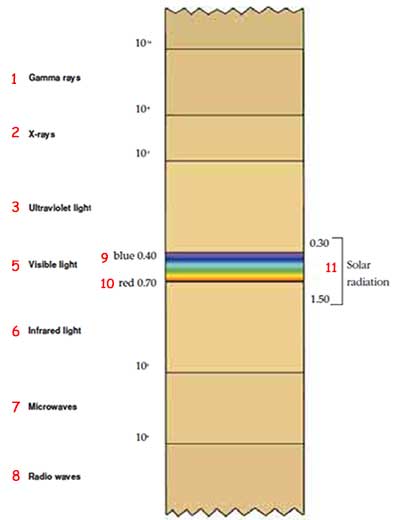 | |
| 1. Gamma rays | 6. Microwaves |
| The stars and other sources of light in the universe do not all give out the same kind of radiation. Instead, they radiate energy with a broad range of wavelengths. Gamma rays, which have the shortest wavelengths, are just 1/1025 the length of the longest radio waves. Strangely enough, nearly all of the radiation emitted by the Sun falls into a single band that is also 1/1025 of the whole spectrum. The reason, is that the only kinds of radiation that are necessary and fit for life fall in this narrow band. | |
The analogy shouldn't be taken too far however because there are huge differences in the wavelengths of electromagnetic radiation. Some are several kilometers long while others are shorter than a billionth of a centimeter and the other wavelengths are to be found in a smooth, unbroken spectrum everywhere in between. To make things easier, scientists divide this spectrum up according to wavelength and they assign different names to different parts of it. The radiation with the shortest wavelength (one-trillionth of a centimeter) for example is called "gamma rays": these rays pack tremendous amounts of energy. The longest wavelengths are called "radio waves": they can be several kilometers long but carry very little energy. (One result of this is that radio waves are quite harmless to us while exposure to gamma rays can be fatal.) Light is a form of electromagnetic radiation that lies between these two extremes.
The first thing to be noticed about the electromagnetic spectrum is how broad it is: the longest wavelength is 1025 times the size of the shortest one. Written out in full, 1025 looks like this:
10,000,000,000,000,000,000,000,000
A number that big is pretty meaningless by itself. Let's make a few comparisons.
For example, in 4 billion years (the estimated age of the Earth) there are about 1017 seconds. If you wanted to count from 1 to 1025 and did so at the rate of one number a second nonstop, day and night, it would take you 100 million times longer than the age of the earth! If we were to build a pile of 1025 playing cards, we would end up with a stack stretching halfway across the observable universe.
This is the vast spectrum over which the different wavelengths of the universe's electromagnetic energy extend. Now the curious thing about this is that the electromagnetic energy radiated by our Sun is restricted to a very, very narrow section of this spectrum. 70% of the Sun's radiation has wavelengths between 0.3 and 1.50 microns and within that narrow band there are three types of light: visible light, near-infrared light, and ultraviolet light.
Three kinds of light might seem quite enough but all three combined make up an almost insignificant section of the total spectrum. Remember our 1025 playing cards extending halfway across the universe? Compared with the total, the width of the band of light radiated by the Sun corresponds to just one of those cards!
Why should sunlight be limited to such a narrow range?
The answer to that question is crucial because the only radiation that is capable of supporting life on earth is the kind that has wavelengths falling within this narrow range.
In Energy and the Atmosphere, the British physicist Ian Campbell addresses this question and says "That the radiation from the Sun (and from many sequence stars) should be concentrated into a minuscule band of the electromagnetic spectrum which provides precisely the radiation required to maintain life on earth is very remarkable." According to Campbell, this situation is "staggering".66
Let us now examine these "staggering features of light" more closely.
We said that there was a range of 1:1025 in the sizes of the longest and shortest electromagnetic wavelengths. We also said that the amount of energy that was carried depended upon the wavelength: shorter wavelengths pack more energy than longer ones. Another difference has to do with how radiation at different wavelengths interacts with matter.
The shortest forms of radiation are called (in increasing order of wavelength) "gamma rays", "X-rays", and "ultraviolet light". They have the ability to split atoms because they are so highly energized. All three can cause molecules–especially organic molecules–to break up. In effect, they tear matter apart at the atomic or molecular level.
Radiation with wavelengths longer than visible light begins at infrared and extends up to radio waves. Its impact upon matter is less serious because the energy it conveys is not as great.
The "impact upon matter" that we spoke of has to do with chemical reactions. A significant number of chemical reactions can take place only if energy is added to the reaction. The energy required to start a chemical reaction is called its "energy threshold". If the energy is less than this threshold, the reaction will never start and if it is more, it is of no good: in either case, the energy will have been wasted.
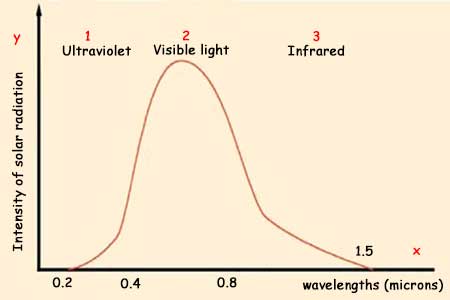 | |
| 1. Ultraviolet | y. Intensity of solar radiation |
| Nearly all of the Sun's radiation is restricted to a narrow band of wavelengths ranging from 0.3 to 1.50 microns. This band encompasses near ultraviolet, visible, and infrared light. | |
In the whole electromagnetic spectrum, there is just one little band that has the energy to cross this threshold exactly. Its wavelengths range between 0.70 microns and 0.40 microns and if you'd like to see it, you can: just raise your head and look around–it's called "visible light". This radiation causes chemical reactions to take place in your eyes and that is why you are able to see.
"The radiation known as "visible light" makes up 41% of sunlight even though it occupies less than 1/1025 of the whole electromagnetic spectrum. In his famous article "Life and Light", which appeared in Scientific American, the renowned physicist George Wald considered this matter and wrote "the radiation that is useful in prompting orderly chemical reactions comprises the great bulk of that of our sun."67 That the Sun should radiate light so exactly right for life is indeed an important example of Creation.
Is the rest of the light the Sun radiates good for anything?
When we look at this part of the light we see that a large part of solar radiation falling outside the range of visible light is in the section of the spectrum called "near infrared". This begins where visible light ends and again occupies a very small part of the total spectrum–less than 1/1025.68
Is infrared light good for anything? Yes, but this time it's no use to look around because you can't see it with the naked eye. However you can easily feel it: the warmth you feel on your face when you look up on a bright sunny summer or spring day is caused by infrared radiation coming from the Sun.
The Sun's infrared radiation is what carries the thermal energy that keeps Earth warm. It too is as essential for life as visible light is. And the fascinating thing is that our Sun was apparently created just to serve for these two purposes, because these two kinds of light make up the greatest part of sunlight.
And the third part of sunlight? Is that of any benefit?
You can bet on it. This is "near ultraviolet light" and it makes up the smallest fraction of sunlight. Like all ultraviolet light, it is highly energized and it can cause damage to living cells. The Sun's ultraviolet light however is the "least harmful" kind since it is closest to visible light. Although overexposure to solar ultraviolet light has been shown to cause cancer and cellular mutations, it has one vital benefit: the ultraviolet light concentrated in such a miniscule band69 is needed for the synthesis of vitamin D in humans and other vertebrates. (Vitamin D is necessary for the formation and nourishment of bone: without it, bones become soft or malformed, a disease called rickets that occurs in people deprived of sunlight for great lengths of time.)
In other words, all the radiation emitted by the Sun is essential to life: none of it is wasted. The amazing thing is that all this radiation is limited to a 1/1025 interval of the whole electromagnetic spectrum yet it is sufficient to keep us warm, see, and allow all the chemical reactions necessary for life to take place.
Even if all the other conditions necessary for life and mentioned elsewhere in this book existed, if the light radiated by the Sun fell into any other part of the electromagnetic spectrum, there could be no life on Earth. It is certainly impossible to explain the fulfillment of this condition having a probability of 1 in 1025 with a logic of coincidence.
And if all this were not enough, light does something else: it keeps us fed, too!
Photosynthesis is a chemical process whose name almost everyone who's ever gone to school will be familiar with. Most people however fail to realize how vitally important this process is for life on Earth or what a mystery its workings are.
First let's brush off our high-school chemistry and take a look at the formula for the photosynthesis reaction:
 |
Translated into words this means: Water and carbon dioxide and sunlight produces glucose and oxygen.
To be more exact what is happening in this chemical reaction is that six molecules of water (H2O) combine with six molecules of carbon dioxide (CO2) in a reaction that is energized by sunlight. When the reaction is complete, the result is a single molecule of glucose (C6H12O6), a simple sugar that is a fundamental element of nutrition, and six molecules of gaseous oxygen (O2). The source of all nutriments on our planet, glucose contains a great deal of energy.
Simple though this reaction may look, it is in fact enormously complex. There is only one place where it occurs: in plants. The plants of this world produce the basic food for all living things. Every other living thing is ultimately nourished in one way or another by glucose. Herbivorous animals eat the plants themselves and carnivorous animals eat plants and/or other animals. Human beings are no exception: our energy is derived from the food we eat and comes from the same source. Every apple, potato, chocolate, or steak or anything else you eat is supplying you with energy that came from the Sun.
But photosynthesis is important for another reason. The reaction has two products: in addition to glucose, it also releases six molecules of oxygen. What's happening here is that plants are continuously cleaning up an atmosphere that is constantly being "polluted" by air-breathing creatures–human beings and animals, whose energy is derived from combustion in oxygen, a reaction that produces carbon dioxide. If plants didn't release oxygen, the oxygen-breathers would eventually use up all the free oxygen in the atmosphere and that would be the end of them. Instead, the oxygen in the atmosphere is constantly being replenished by plants.
 |
| For hundreds of millions of years, plants have been busy doing something no laboratory has ever been able to duplicate: Using sunlight, the produce food. A crucial condition for this extraordinary transformation however is that the light that the plants receive must be precisely right for photosynthesis to take place. |
Without photosynthesis, plant life could not exist; and without plant life, there would be no animal or human life. This marvelous chemical reaction, which has never been duplicated in any laboratory, is taking place deep in the grass you step on and in trees. It once occurred in the vegetables on your dinner plate. It is one of the fundamental processes of life.
When we study photosynthesis, we can't help but observe that there is a perfect balance between plant photosynthesis and the energy consumption of oxygen-breathers. Plants supply glucose and oxygen. Oxygen-breathers burn the glucose in the oxygen in their cells to get energy and they release carbon dioxide and water (in effect, they're reversing the photosynthesis reaction) that the plants use to make more glucose and oxygen. And so it goes on, a continuous cycle that is called the "carbon cycle" and it is powered by the energy of the Sun.
In order to see how perfectly-created this cycle truly is, let us focus our attention on just one of its elements for the moment: the sunlight.
In the first part of this chapter we looked at sunlight and found that its radiation components were specially tailored to allow life on Earth. Could sunlight also be deliberately tailored for photosynthesis as well? Or are plants flexible enough so that they can perform the reaction no matter which kind of light reaches them?
The American astronomer George Greenstein discusses this in The Symbiotic Universe:
Chlorophyll is the molecule that accomplishes photosynthesis... The mechanism of photosynthesis is initiated by the absorption of sunlight by a chlorophyll molecule. But in order for this to occur, the light must be of the right color. Light of the wrong color won't do the trick.
The Fitness of Sunlight and Chlorophyll |
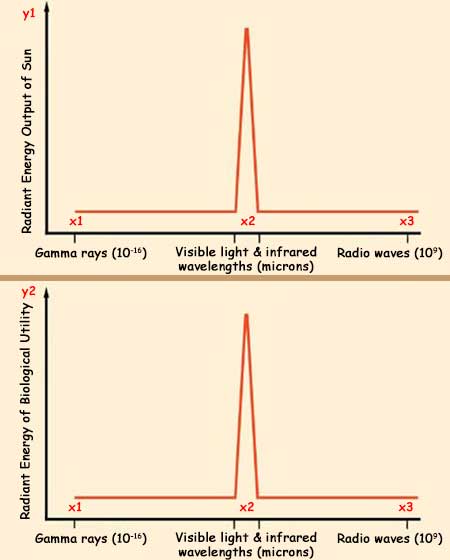 |
| y1. Radiant energy output of Sun x1. Gamma rays (10-16) |
| Plants are able to perform photosynthesis because the chlorophyll molecules in their cells are sensitive to sunlight. But chlorophyll is only able to use a very limited range of light wavelengths and those are the wavelengths that the Sun radiates the most. What is even more interesting is that this interval corresponds to just 1/1025 of the whole electromagnetic spectrum. In the two graphs above, the extraordinary fitness between sunlight and chlorophyll can be seen. In the upper chart is the distribution of the light emitted by the Sun. In the lower one is the light under which photosynthesis will work. The fact that these two curves are almost identical is an indication of how perfectly created visible light is. |
A good analogy is that of a television set. In order for the set to receive a given channel it must be tuned to that channel; tune it differently and the reception will not occur. It is the same with photosynthesis, the Sun functioning as the transmitter in the analogy and the chlorophyll molecule as the receiving TV set. If the molecule and the Sun are not tuned to each other-tuned in the sense of colour- photosynthesis will not occur. As it turns out, the sun's color is just right.70
In the last chapter we drew attention to the error inherent in the idea of the adaptability of life. Some evolutionists hold that "if conditions had been different, life would have evolved to be perfectly in harmony with them as well". Thinking superficially about photosynthesis and plants, one could come to a similar conclusion: "If sunlight were different, plants would have just evolved according to that." But this is in fact impossible. Although he's an evolutionist himself, George Greenstein admits this:
One might think that a certain adaptation has been at work here: the adaptation of plant life to the properties of sunlight. After all, if the Sun were a different temperature could not some other molecule, tuned to absorb light of a different colour, take the place of chlorophyll? Remarkably enough the answer is no, for within broad limits all molecules absorb light of similar colours. The absorption of light is accomplished by the excitation of electrons in molecules to higher energy states, and the same no matter what molecule you are discussing. Furthermore, light is composed of photons, packets of energy and photons of the wrong energy simply can not be absorbed… As things stand in reality, there is a good fit between the physics of stars and that of molecules. Failing this fit, however, life would have been impossible.71
What Greenstein is saying briefly is this: No plant can only perform photosynthesis except within a very narrow range of light wavelengths. And that range corresponds exactly to the light given out by the Sun.
The harmony between stellar and molecular physics that Greenstein refers to is a harmony too extraordinary ever to be explained by chance. There was only one chance in 1025 of the Sun's providing just the right kind of light necessary for us and that there should be molecules in our world that are capable of using that light. This perfect harmony is unquestionably proof of Creation.
In other words, there is a single Creator, the Ruler of starlight and of the molecules of plants Who has created all these things in harmony with one other, exactly as is revealed in the Qur'an:
He is Allah–the Creator, the Maker, the Giver of Form. To Him belong the Most Beautiful Names. Everything in the heavens and earth glorifies Him. He is the Almighty, the All Wise. (Surat al-Hashr: 24)
We have seen how the light coming to us from the Sun consists of just three narrow bands of the electromagnetic spectrum:
The existence of a range of "visible light" is as important for the support of biological vision as it is for photosynthesis. The reason is that it is impossible for a biological eye to see any band of the spectrum outside that of visible light and a very small section of near infrared.
To explain why this should be so, we first need to understand how vision takes place. It begins with particles of light called "photons" passing through the pupil of eye and falling onto the surface of the retina located at the back of the eye. The retina contains cells that are light-sensitive. They are so sensitive that each can recognize when even a single photon strikes it. The photon's energy activates a complex molecule called "rhodopsine", large quantities of which are contained in these cells. The rhodopsine in turn activates other cells and those activate still others in turn.72 Eventually an electrical current is generated and this is carried to the brain by the optic nerves.
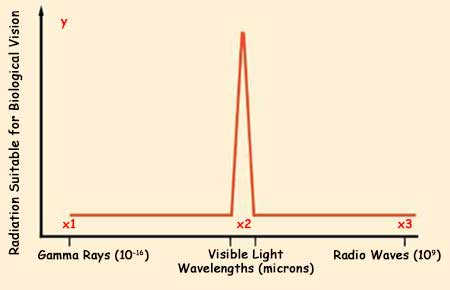 |
| y. Radiation suitable for biological vision x1. Gamma Rays (10-16) |
| Our Sun has a surface temperature of about 6,000°C. If this temperature were even slightly more or less, the resulting sunlight would be incapable of supporting life. |
The first requirement for this system to work is that the retina cell must be able to recognize when a photon strikes it. For that to happen, the photon must carry an exact amount of energy: if it is too much or too less, it won't activate the formation of rhodopsine. Changing the size of the eye makes no difference: the crucial thing is the harmony between the size of the cell and the wavelengths of the photons coming in.
Making an organic eye that could see other ranges of the electromagnetic spectrum turns out to be impossible in a world dominated by carbon-based life. In Nature's Destiny, Michael Denton explains this subject in detail and confirms that an organic eye can only see within the range of visible light. While other models of eyes that could, in theory, be produced, none of them would be able to see different ranges of the spectrum. Denton tells us why:
UV, X-ray, and gamma rays are too energetic and are highly destructive, while infrared and radio waves are too weak to be detected because they impart so little energy interacting with matter... And so it would appear that for several different reasons, the visual region of the electromagnetic spectrum is the one region supremely fit for biological vision and particularly for the high-resolution vertebrate camera eye of a design and dimension very close to that of the human eye.73
Pausing to think about everything that has been said so far, we come to this conclusion: The Sun radiates energy within a narrow band (a band so narrow that it corresponds to just 1/1025 of the whole electromagnetic spectrum) that has been carefully chosen. So finely adjusted is this band that it keeps the world warm, supports the biological functions of complex life-forms, enables photosynthesis, and allows the creatures of this world to see.
 |
| Our Sun has a surface temperature of about 6,000°C. If this temperature were even slightly more or less, the resulting sunlight would be incapable of supporting life. |
In "The Blue Planet" we compared our world with the other planets of the solar system and found that the range of temperatures necessary for life exists only on Earth. The biggest reason for this is that the Earth is just the right distance from the Sun: the outer planets like Mars, Jupiter, or Pluto are too cold while the inner planets Venus and Mercury are too hot.
Those who refuse to admit that the distance between Earth and Sun is specially created, suggest something like the following: "The universe is full of stars, some of them much bigger than the Sun and some of them much smaller. These could very well have planetary systems of their own. If a star is bigger than the Sun, then the ideal planet for life would be located at a much greater distance than the Earth is from the Sun. For example, a planet in an orbit around a red giant at the distance of Pluto could have a temperate climate like our world has. Such a planet would be just as fit for life as our Earth is."
The claim is invalid in one very important respect for it ignores the fact that stars of different masses radiate different types of energy.
The factors that determine the wavelengths of the energy that a star radiates are its mass and its surface temperature (the latter of which is directly related to mass). For example, the Sun radiates near ultraviolet, visible, and near infrared light because its surface temperature is around 6,000°C. If the Sun's mass were a bit bigger, its surface temperature would be higher; but in that case, the energy levels of the Sun's radiation would also be higher and the Sun would be radiating much more destructive ultraviolet rays than it does.
This tells us that any star that is to radiate light that will support life absolutely must have a mass close to that of our Sun. But if there are to be life-supporting planets orbiting around such stars, those planets must be located at distances not substantially different from that between the Earth and the Sun.
In other words, no planet revolving around a red giant, a blue giant, or any other star whose mass was substantially different from the Sun's could harbor life. The only source of energy capable of supporting life is a star like our Sun. The only planetary distance that is suitable for life is the distance between the Earth and the Sun.
There is another way of expressing this truth: The Sun and the Earth were each created to be just as they needed to be. And indeed, in the Qur'an it is revealed that Allah created everything according to precise calculation:
It is He Who splits the sky at dawn, and appoints the night as a time of stillness and the Sun and Moon as a means of reckoning. That is what the Almighty, the All-Knowing has ordained. (Surat al-An’am: 96)
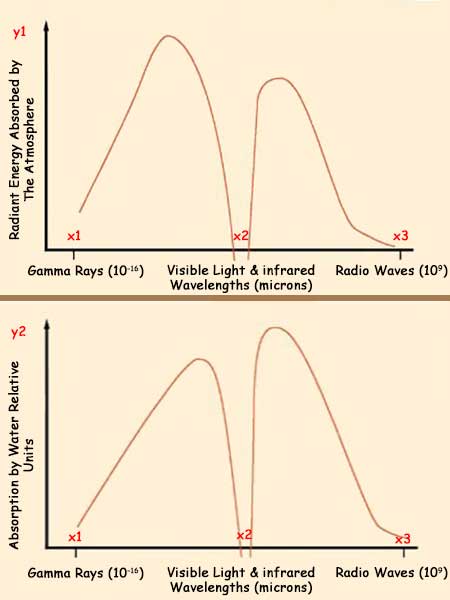 |
| y1. Radiant energy absorbed by the atmosphere x1. Gamma Rays (10-16) |
| Air as well as water allows the passage of only that radiation that is necessary for us to live. All the harmful and deadly cosmic radiation coming from distant space is caught in this perfectly-created filter. |
Since the beginning of this chapter we have been talking about the radiation given out by the Sun and how it was specially created to support life. There is yet another crucially important factor that we have not yet touched upon: In order for this radiation to reach the Earth's surface, it has to pass through the atmosphere.
Sunlight certainly couldn't do us any good if the atmosphere didn't let it through. But it does; in fact, our atmosphere is specially created to be transparent to this beneficial radiation.
The really interesting thing is not so much that the atmosphere allows beneficial sunlight to pass but that sunlight is the only radiation that it allows through. The atmosphere lets in the visible and near infrared light that is necessary for life but it blocks other forms of radiation that are deadly. This makes the atmosphere an important filter against the cosmic radiation that reaches the Earth from the Sun and from other sources. Denton has this to say about the matter:
Atmospheric gases themselves absorb electromagnetic radiation immediately on either side of the visible and near infrared... The only region of the spectrum allowed to pass through the atmosphere over the entire range of electromagnetic radiation from radio to gamma rays is the exceedingly narrow band including the visible and near infrared. Virtually no gamma, X, ultraviolet, far infrared, and microwave radiation reaches the surface of the Earth.74
It is impossible to ignore the artfulness of this structure. The Sun sends only 1/1025 of the whole range of electromagnetic radiation that could be sent, that happens to be the range that is good only for us, and that is the radiation that the atmosphere lets through! At this point it's also worth pointing out that nearly all of the near ultraviolet that the Sun radiates gets trapped by the atmosphere's ozone layer.
Another point that makes this even more interesting is that, like air, water also has an extremely particular sort of transparency: the only radiation capable of spreading through water is the range of visible light. Even near infrared radiation, which penetrates the atmosphere (and thus provides heat) penetrates only a few millimeters into water. Because of this, only a few millimeters of the surface of the world's oceans are heated by radiation from the Sun. That heat is conveyed in stages to lower levels and as a result of this, below a particular depth, the temperature of the seawater is quite similar all over the world. This of course creates an environment quite suitable for life.
Another interesting point concerning water is that the different colors of visible light are able to travel different distances in it. Below eighteen meters, for example, red light cannot penetrate while yellow can reach depths of up to a hundred meters. Blue and green on the other hand descend to 240 meters. This is an extremely important feature because the light that is particularly crucial for photosynthesis is the blue and green portion of the spectrum. Since water allows these colors to penetrate more deeply than the others, photosynthesizing plants can live up to 240 meters beneath the surface.
These are all facts of the utmost importance. No matter what physical law related to light we examine, we discover that everything has been exactly arranged so that life can exist. Commenting on this situation, Encyclopedia Britannica admits how extraordinary it all is:
Considering the importance of visible sunlight for all aspects of terrestrial life, one can not help being awed by the dramatically narrow window in the atmosphere absorption and in the absorption spectrum of water. 75
Materialist philosophy and Darwinism, which takes materialism as its source, both claim that human life appeared in the universe by chance and that it is an "accident" with no purpose whatsoever. The knowledge that is being gained through advances in science however is showing that, in every detail of the universe, there is an order and a plan which is created to make life possible. It is such an order that, even such a component as light, which we might never have thought about before, is so clearly "just right" that one can't help but be amazed.
To try and explain such perfect structure as "accidental" is irrational. The fact that all the Sun's radiation is constricted to a narrow band just 1/1025 of the total electromagnetic spectrum, the fact that the light necessary for life falls precisely within that narrow band, the fact that the atmosphere blocks all other wavelengths of radiation and admits just these, the fact that water also blocks all other forms of deadly radiation and permits the passage only of visible light: Can these really all be coincidences? Such extraordinary fine-tuning as this can be explained not by chance but only by Creation. This in turn shows us that the whole universe and all the details of that universe–including the light of the Sun that enables us to see and keeps us warm–have been specially created and arranged for life.
 |
| Although it blocks all other forms of radiation, water allows visible light to penetrate into its depth for many meters. Because of this, sea plants are able to perform photosynthesis. If water did not have this property, the ecological balance necessary for life on our planet could not have come into being. |
The conclusion reached by science is a truth that has been taught to mankind in the Qur‘an for fourteen centuries. Science shows that sunlight has been created for us, in other words, that it has been made to be "at our service". In the Qur'an we are told that "The Sun and Moon both run with precision." (Surat ar-Rahman: 5) Elsewhere it is stated:
Allah is He Who created the heavens and the earth and sends down water from the sky and by it brings forth fruits as provision for you. He has made the ships subservient to you to run upon the sea by His command, and He has made the rivers subservient to you, and He has made the Sun and Moon subservient to you holding steady to their courses, and He has made the night and day subservient to you. He has given you everything you have asked Him for. If you tried to number Allah's blessings, you could never count them. Man is indeed wrongdoing, ungrateful. (Surah Ibrahim: 32-34)
65. Ian M. Campbell, Energy and the Atmosphere, London: Wiley, 1977, p. 1-2
66. Ian M. Campbell, Energy and the Atmosphere, p. 1-2
67. George Wald, "Life and Light", Scientific American, 1959, vol. 201, p.92-108
68. The near infrared range occupies the rays which extends from 0.70 micron, where visible light ends, to 1.50 micron
69. This narrow range occupies the ultraviolet rays between 0.29 micron and 0.32 micron
70. George Greenstein, The Symbiotic Universe, p. 96
71. George Greenstein, The Symbiotic Universe, p. 96-7
72. This chain reaction taking place in the eye is actually much more complicated. The light reaching the eye passes through the lens and falls upon the retina in the back. When light first strikes the retina a photon interacts with a molecule called 11-cis-retinal. The change in the shape of the retinal molecule forces a change in the shape of the protein, rhodopsin, to which the retinal is tightly bound. The protein's metamorphosis alters its behaviour. Now called metarhodopsin II, the protein sticks to another protein, called transducin. Before bumping into metarhodopsin II, transducin had tightly bound a small molecule called GDP. But when transducin interacts with metarhodopsin II, the GDP falls off, and a molecule called GTP binds to transducin. Now, two proteins and one chemical molecule are bound to one another and it is called GTP-transducin-metarhodopsinII. It now binds to a protein called phosphodiesterase. When attached to metarhodopsin II and its entourage, the phosphodiesterase acquires the chemical ability to "cut" a molecule called cGMP. Initially there are a lot of cGMP molecules in the cell, but the phosphodiesterase lowers its concentration, just as a pulled plug lowers the water level in a bathtub.Another protein that binds cGMP is called an ion channel. It acts as a gateway that regulates the number of sodium ions in the cell. Normally the ion channel allows sodium ions to flow into the cell, while a separate protein actively pumps them out again. The dual action of the ion channel and pump keeps the level of sodium ions in the cell within a narrow range. When the amount of cGMP is reduced because of cleavage by the phosphodiesterase, the ion channel closes, causing the cellular concentration of positively charged sodium ions to be reduced. This causes an imbalance of charge across the cell membrane that, finally, causes a current to be transmitted down the optic nerve to the brain. The result, when interpreted by the brain, is vision. (Quoted from Michael Behe, Darwin's Black Box, New York: Free Press, 1996, pp. 18-21).This is actually a very brief and simplified version of how we see. If the events developed like this, we would never be able to see. If the reactions mentioned above were the only ones that operated in the cell, the supply of 11-cis-retinal, cGMP, and sodium ions would quickly be depleted. There are many mechanisms that would restore the cells to their original state. The reactions described above is far from being a complete biochemical explanation of seeing and they are only summarized. However, even what has been related above suggests that seeing is a very complicated and perfect mechanism which can never come about by evolution.
73. Michael Denton, Nature's Destiny, p 62, 69
74. Michael Denton, Nature's Destiny, p. 55
75. Encyclopaedia Britannica, 1994, 15th ed., volume 18, p. 203